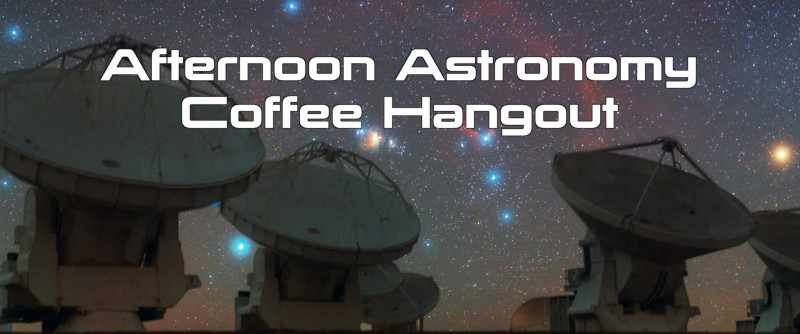Afternoon Astronomy Coffee Hangout on 23 March
Carol Christian STScI
"Found Water: Exoplanet 51 Peg b!"
Afternoon Astronomy Coffee Hangout
The first exoplanet ever discovered orbiting another normal star was 51 Peg b, named after its parent star, 51 Pegasus. It is a Jupiter-sized planet which orbits around its star in four days. This discovery challenged the understanding of planet formation at the time. The exoplanet was uncovered by measuring the star’s light in detail (a spectrum) which showed periodic shifting due to the planet’s gravitational pull. It was realized that the light of the planet should exhibit similar shifting in response. If the faint light from the planet could be detected, it could tell a lot about the planet itself. Find out how the science team managed to observe the planet and how, through careful analysis of the data and cleaning out any contaminating effects (like that produced by our own Earth’s atmosphere), they could tell that 51 Peg b probably has water in the atmosphere — we don't know if there is a surface or if it would contain water, however.
Join regular hosts Tony Darnell and Carol Christian on Thursday, 23 March, at 3:00 pm ET as they chat with Jayne Birkby (Harvard-Smithsonian Center for Astrophysics), Remco Dekok (Utrecht University), Matteo Brogi (University of Colorado, Boulder), and Henriette Schwarz (University of California, Santa Cruz) about the discovery and observations of this famous planet and how they arrived at the exciting result that the planet’s atmosphere contains water. The best place to hangout with us will be on YouTube, broadcast on the Deep Astronomy Channel. The direct link for this hangout will be posted to the Deep Astronomy Facebook page closer to the event. You can also take part in the live chat and join the conversation on Twitter with #AstroCoffee. An archive of previous hangouts in this series may be found in a Deep Astronomy YouTube playlist.

What Are Afternoon Astronomy Coffee and Future in Space Hangouts?
Future In Space” and "Afternoon Astronomy Coffee" Hangouts are part of a weekly series, held every Thursday, that also includes a segment on Footsteps to Mars. We bring the the latest research in astronomy, highlights from the future of space astronomy and astronautics planning, as well as updates on the exploration of Mars to you every week via Hangouts on Air. With the cooperation of both the American Astronomical Society (AAS) and the American Astronautical Society (the other AAS), our hosts Tony Darnell, Carol Christian, Alberto Conti, and Harley Thronson bring you topics that examine today's breakthroughs in research and look forward to peer into the unfolding possibilities of what we may learn about the universe and Mars exploration. We join with members of the American Astronomical Society to chat, in an informal online setting modeled after "science coffee" events held in universities and research organizations across the country. We will examine what we hope to learn about exoplanets, black holes, the early universe, quasars, and life in the universe along with what technologies might help us — and reflect upon the scientific endeavors occurring today that uncover amazing astrophysics and lay the groundwork for studies to come.
We will also explore the technology and engineering used today as well as possibilities for future space travel and research with members of both Societies, and probe what our future in space may look like and how we might get there. We will examine the underlying technologies of space telescopes, orbiters, landers, and human space vehicles now and in the years to come. We will delve into topics that help us understand the possibilities and limitations of human space flight and eventual human colonization of other worlds.
We hope you can join us each month as we bring experts from both Societies — people who think about and plan for our future in space — to your computer, tablet, or smartphone. We invite you to bring your questions and comments and get ready to learn about the amazing possibilities for the future of space astronomy and exploration.

